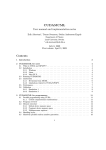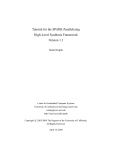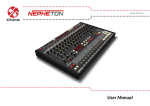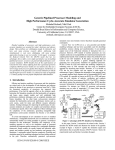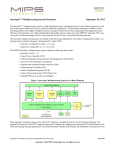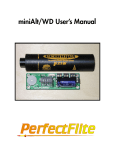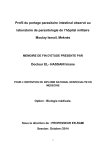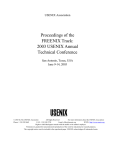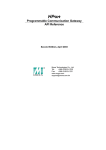Download An FPGA-based Multi-Core Platform for Testing and Analysis of
Transcript
An FPGA-based Multi-Core Platform for Testing and Analysis of Architectural Techniques Willard G. Simoneau and Resit Sendag Department of Electrical, Computer and Biomedical Engineering University of Rhode Island Kingston, RI 02881 simoneau,[email protected] Abstract—This paper covers the design and FPGA-based prototyping of a full-featured multi-core platform for use in computer architecture research studies. Existing platforms for performing studies include software simulators and hardwareassisted simulators, but there are no modular full-hardware platforms designed to measure a wide range of performance metrics. Such a platform, using HDL synthesis onto an FPGA, can run orders of magnitude faster than software-based solutions at the cost of having less flexible processor configuration and implementation. This paper presents an end-to-end solution, from bottom-level hardware design all the way to automated results collection and analysis, which can be used with inexpensive commodity hardware. I. I NTRODUCTION In computer architecture, there is a growing need to evaluate the performance and cost of new, complex architectural ideas. Currently, most evaluation is done with simulations [1], [2], [3], [9], [11], [20], but these simulators are typically quite slow. It is difficult to get accurate results quickly. Consequently, there has been research into hardware acceleration of these simulators using FPGAs (field-programmable gate arrays) [7], [6], [18], [17], [8], [5], [12], [19], [16], [4], [14]. Many of these techniques use a seperate functional model (usually [7], [17], [14] but not always [8] softwarebased) paired with an FPGA-based timing model. FPGAaccelerated models are several orders of magnitude faster than their software counterparts, especially when simulating multicore systems. Current FPGA-accelerated simulation platforms have demonstrated FPGAs as viable architecture research vehicle. However, they fall short in terms of providing tools which are fully open-source and easy to experiment with. For example, HAsim[13] and FAST[7] provide valuable insight into how FPGA-accelerated simulators can be designed, but they are not open-source. Their utility is limited to a few research groups in academia and industry. The difficulty in designing and verifying an FPGA-accelerated simulator leads to a scarcity of tools. The few existing open-source tools (e.g., RAMP Gold [17] and ProtoFlex [8] are not straightforward to use, modify and/or generate results with. The end result is that FPGA-accelerated simulators have not become popular in computer architecture research community. More FPGA platforms are needed to popularize their use in the research community. These systems should preferably provide a full solution: easy to use, modify, debug and verify, and an automated experiment setup. To address this need, we introduce in this paper a new FPGA-based architecture exploration platform, the Z48001 . The Z4800 is not aimed at replacing any existing FPGAaccelerated simulation platforms: for different type of research studies as well as educational objectives, different tools will be appropriate. The Z4800 focuses on testing and analysis of single-core and small-scale (2-16 core) multi-core systems rather than large-scale systems such as those targetted by ProtoFlex and RAMP Gold. It can run unmodified Linux-based operating systems over network filesystems such as NFS or from local storage such as a USB drive. The main design philosophy of the Z4800 is centered around ease of adaptation and use. It is supported by a fully automatic synthesis and benchmarking system that provides a mechanism to run a large number of experiments with no human intervention. It also provides extensive run-time debug and verification interfaces. Consequently, it is an end-to-end FPGA-based platform that can be used not only for computer architecture research, but also for operating system research and for software debugging. II. Z4800: A C ONFIGURABLE AND M ODULAR FPGA C OMPUTER The Z4800 is an open-source multi-core research platform which can be directly synthesized for a commodity FPGA and can run a full, unmodified Linux-based operating system. It can be configured to run at up to 55MHz while achieving 0.7 average per-core IPC (instructions per clock cycle) using only a $300 FPGA board. Per-core IPC of up to 0.85 can be achieved with larger caches at the expense of FPGA resource consumption. The design is modularized, so that individual components can be replaced and redesigned to test new architectural ideas. The design also has extensive instrumentation; a large number of performance counters (currently 80) are used 1 The Z4800 implements a 32-bit subset of the MIPSR4000 R ISA. Most MIPS implementations use R as their first letter, so we have used Z. Other R R MIPS implementations include the R4000, R4400, and so on. We arbitrarily pick the name Z4800 because it is capable of running code compiled R for R4xxx processors, including kernel code. MIPSis a registered trademark of MIPS Technologies, Inc., and the Z4800 is not endorsed by nor associated with MIPS Technologies, Inc. to simultaneously measure a wide range of statistics in realtime. It also provides a fully-automated hardware synthesis and benchmarking system and an extensive debug interface. It promotes simplicity, ease of use and adaptability. The Z4800 is synthesizable on many Altera FPGAs; on the Altera DE2-115, a $300 FPGA board based on an inexpensive Cyclone IV-E chip, a 4-core system is quite practical. Larger systems with 16 or more cores are possible in high-end Stratix FPGAs. Frontend pipeline Decode/group logic Backend pipeline (pipeline, ALU/mul/div, Coprocessor 0) L1/L2 caches, cache controllers, and glue logic Replacement Algorithms (LRU, Pseudo-LRU, Random, Hybrid) L1 TLBs, JTLB Debug features (not necessary for running CPU) Performance counters TOTAL 394 1200 1602 2304 528 855 474 60 10090 TABLE I: Number of lines of VHDL code for Z4800, including optional debug modules. A. Design Philosophy The Z4800 takes on a somewhat unique design philosophy. The central idea is that functionality and ease of design are more important than other design metrics (area, speed, power, etc). Instead of focusing on maximizing performance per logic block and micro-optimization, the Z4800 instead uses highlevel RTL (register-transfer level) constructs. Synthesized area is traded for easier RTL, modularity, and more aggressive design on an architectural level. The resulting design runs at moderate clock rates, but it can easily be modified to study various architectural enhancements. Blocks such as the cache controllers and TLBs (translation lookaside buffers) are split into seperate VHDL (VHSIC (very high speed integrated circuit) hardware description language) entities so that they can be rewritten and replaced independently. However, modularization does not extend much beyond this level. This is beneficial because over-modularization would obfuscate the design; imagine trying to make sense of a design in which every gate and flip-flop was instantiated seperately. One must consider the human writing the HDL as part of the design process. The time and effort of handoptimizing the HDL could be the difference between a design that functions and one that does not; tolerating higher logic consumption results in a bigger, slower, but still functional design. Besides, with an appropriately modularized design, one can always return to optimize the problematic parts of the design once absolute correctness is achieved. The ultimate proof of this design philosophy is in the results. The fully functional processor is about 10K lines of VHDL code, including all comments and whitespace. Much of that code is simply signal routing between modules. The core’s logic is instantiated using only a few thousand lines of code. More details are shown in Table I. The compilation of the design is also very fast. Using a reasonable host system, it takes about 11 minutes to compile a fully functional system with 1 core, 15 minutes for 2 cores, and 40 minutes for 4 cores.2 . 2 These are worst-case cold compile times including all phases (analysis, synthesis, fitting, timing analysis) targetted for the DE2-115 board. Incremental compilation and reduced cache/TLB configurations will improve on these compile times. The 4-core design begins pushing the limits of the FPGA, so its compile time is much longer. If a larger FPGA is used, compilation time can be greatly decreased since less place/route effort is required. The host machine used here was a Dell Poweredge 1950 with a pair of quad-core Xeon X5460 CPUs and 32GB RAM. B. Microarchitecture The Z4800 processor features a 2-issue in-order integer pipeline. It can execute most instructions supported by the MIPS R4000, except 64-bit and floating-point operations. The Z4800 includes a full-featured TLB which maintains compatibility with the R4000 TLB. The implemented ISA is sufficient to run unmodified GNU/Linux distributions such as Debian. The Z4800 processor aims for high IPC at moderate clock rates, and emphasizes simplicity and modularity when reasonable. This is done at the expense of area, and to a lesser extent, clock speed. The Z4800 is superscalar with symmetric in-order pipelines. The number of stages is configurable at compile time. The overall pipeline organization is shown in Figure 1. 1) Instruction Fetch and Instruction Queue: The Z4800 includes hardware which prefetches instructions along the predicted path. An instruction queue seperates the frontend from the rest of the pipeline and allows the frontend to run ahead along the predicted code path while the backend is stalled. The frontend is capable of prefetching instructions at a rate of two per cycle, even across cacheline and page boundaries. This serves to hide some of the Icache and ITLB miss penalties. The frontend pre-decodes instructions and is able to predict both taken and not-taken branches with 0 penalty cycles. Fetched instructions are written into the Iqueue (instruction queue), which is drained by the DG (Decode and Group) stage. 2) Speculative Exception Handling: ITLB faults are raised speculatively on the Z4800. The decode stage rewrites instructions that have faulted the ITLB into trap instructions. The trap instructions internally have the same opcode as the explicit MIPS software traps, but the exception that is raised will use the appropriate TLB exception code. If the faulting ITLB access is a wrong-path reference, it will be annulled by a pipeline flush and therefore it will have no architecturally visible effects. This logic cleanly handles many rather difficult corner cases, such as a branch at the last word in a page. In this case, the delay-slot instruction in the next page may cause a TLB exception. The decode stage will rewrite the faulting instruction to a trap in the branch’s delay-slot, resulting in an exception raised with EPC (the exception restart address) pointing to the branch. This is correct behavior [10, Page 121]. RR EX M1 RW BP Icache Dcache Iqueue DG Rfile mul/div cop0 predecode RR EX M1 RW BP Fig. 1: Pipeline organization 3) Decode and Group (DG): The DG stage routes machine code from the instruction queue through the instruction decoders and the grouper. Two candidate instructions are read from the queue and decoded into pipeline control signals. If the grouper decides it is safe to issue them in parallel, then both are issued and the Iqueue advances by 2 words. If parallel issue is not safe, then only the first instruction will issue to pipe 0, pipe 1 will be issued a NOP, and the Iqueue will only advance by 1 word. If later pipeline stages are stalled, nothing is issued and the Iqueue does not advance. If the first of the two instructions coming from the Iqueue is a branch, then the second instruction is its delay slot instruction. A rather simple approach to handling branch delay slots is used: delay slot instructions are always issued in parallel with the branch. If the delay slot instruction is not present (i.e. Iqueue only contains one valid word) then the branch will not issue until it becomes available. 4) Register Read (RR): In the RR stage, the register file is read to provide four operands for two instructions. Operands from later pipeline stages are muxed with the output from the register file. If an operand is marked as invalid, then the data has been overwritten but is not known yet; use of such an operand will cause this stage to stall. Invalid operands are generated by late-result instructions such as loads; this causes RAW-dependent (read-after-write dependent) instructions to stall. An entire pipeline stage is dedicated to this operation to avoid it becoming the critical path. 5) Execute (EX): In the EX stage, the ALU will perform the necessary operation. Data cache virtual addresses are calculated here as well. This stage is the first stage at which operands are guaranteed ready. Branches are resolved as well; EX will trigger a pipeline flush if a branch mispredicts. Of particular note in this stage is the support for operand cascading. If this option is turned on, the Z4800 can issue pairs of instructions that are RAW-dependent. A direct combinational path is provided from the ALU in pipe 0 to the operand inputs of pipe 1. This means that the ALUs only have half a clock cycle each to perform their operations. It is important to note that the instruction in pipe 1 need not be an ALU instruction; it could be any instruction. All basic register-to-register instructions (other than memory accesses) effectively have zero latency and can pair with any other dependent instruction. For example, the result of an addition or barrel shift can be cascaded into the virtual address calculation of a concurrently executing load or store. 6) Memory (M): In the M stage, the first changes to architecturally-visible state are allowed. The Dcache, multiply/divide unit, and coprocessor 0 interface are in this stage. With a Dcache latency of 1, this stage also contains a barrel shifter and sign extension unit for handling non-word loads. All possible exceptions are detected and resolved in this stage. By preventing any changes to visible state from occuring until exceptions are resolved, we completely avoid the need for rollback logic. 7) Register Write (RW): In the RW stage, the register file write ports are driven. Due to internal cross-port latency of the FPGA’s embedded RAMs, data written here will not be visible at the read ports until 2 cycles later. Bypassing is required to hide this latency. 8) Bypass (BP): The BP stage contains very little logic. Its only purpose is to hide the cross-port latency of the register file. C. Z4800 Register File The Z4800’s register file is somewhat difficult to implement efficiently in an FPGA. 2 write and 4 read ports are needed to satisfy 2 MIPS instructions per cycle. Additionally, an optional 5th read port should be available for debug purposes. One obvious approach to take would be to time-multiplex the register file. With a single dual-port memory block, the clock would have to multiplied by a factor of 4 to handle the 7 total read/write operations per pipeline cycle. The problem with time-multiplexing is that it is difficult to control timing on an FPGA. The address input of the RAM must set up 4 times per pipeline cycle, and must not violate the hold time requirement of the RAM input register. This also means a wide mux must select from 1 of 4 addresses, at the high-speed clock rate. Further, the high-speed clock must be phase-synchronized with the pipeline clock. This means that the pipeline clock must be divided from the register clock, and the relative phase of these two clocks must be preserved when they are routed around the FPGA. Any uncertainty or skew in the clock signal reduces the margins of setup and/or hold timing, relative to the high-speed clock. These delays can quickly eat away the entire clock period, resulting in a low maximum clock rate. Early versions of the Z4800 used a 2x-multiplied register file clock and two dual-port RAMs; this achieved only 60MHz, which restricted the pipeline clock to under 30MHz. Instead of time-multiplexing, the Z4800 takes a simpler but larger approach. This method can be used to create arbitrarily large NxM-port memories without any time-multiplexing, although it scales by O(n · m) in area. The key idea is to recognize that a dual-port RAM can be arranged with 1 read and 1 write port; the RAM thus contains the most up-to-date register data written by that write port. We can duplicate this structure N times, where N is the number of read ports. If the write inputs are all tied together then every copy contains the same data, and we now have an independent port to service each read. By arranging these rows of RAMs, one row per architected write port, we can now store data from every write port. To read the most up-to-date data at a given address, all RAMs in a row are read in parallel; the data from the most recently written RAM should be selected by a mux. This mux is controlled by a small table storing the index of the most recent writer of each register. For the Z4800’s case of 32 32-bit registers and 2x5 ports, we require 11 RAM blocks: a 2x5 grid of 32x32 RAMs plus a single 32x1 RAM. This register file design, despite being large, is capable of high-speed operation. It has been used successfully at 50MHz without it becoming the critical path. Its simple design, high clock frequency, and the fact that it does not require a special clock makes it the implementation of choice for the Z4800. JTLB hardware will respond with a 4K slice of the appopriate mapping, regardless of its size. This design is similar to that used by the RM7000 [15]. The JTLB back-invalidates any potentially stale L1 TLB entries as necessary. III. M ULTI - CORE S UPPORT The Z4800 includes hardware support for SMP cachecoherence based on a snoopy protocol. This design gives full Icache, Dcache, and DMA coherence with sequential consistency. Snoops are broadcast to all agents (CPUs and DMA bridges), 1 per cycle globally. The snoop signals are organized into an emulated tristate bus. The arbitration for this bus is pipelined. The overall latency is 3 cycles, with throughput of 1 request per cycle. The bus supports an arbitrary number of agents3 ; it is limited only by practical fan-in, fan-out, and contention issues, not by any fixed tag or ID field sizes. The snoop pipeline is in-order and locks up only when an actual conflict is detected by an agent. A. Cache coherence implementation The Z4800 uses a version of the MESI cache coherence protocol. Due to the internal implementation, particularly the fact that local cache requests are seralized and atomic with regard to external snoop requests, the cache coherence state machine is quite simple; no additional transient states are required. Figure 2 shows all possible states as well as the transition conditions for all cases. minstate=MODIFIED refill EXCLUSIVE D. TLBs The Z4800 contains two level-1 TLBs (ITLB and DTLB, which are modules embedded into the Icache and Dcache) and a main level-2 TLB, the joint TLB (JTLB). The Z4800 uses a single-cycle L1 DTLB and is VIPT. This allows the cache tags and DTLB to be accessed in parallel. With a late wayselect, we can hit the cache in 1 cycle. Cache aliasing does not occur for way sizes less than or equal to 4K, the minimum page size. This method does not require speculation and allows set-associative operation without any special considerations. The JTLB matches the behavior of the R4000’s TLB for software compatibility. It is architecturally visible and is under control by the MIPS Coprocessor 0 instruction set. Hardware in the joint-TLB (JTLB) enforces coherence between the JTLB and the two L1 TLBs; a policy of strict inclusion is adopted so that the L1 TLBs are architecturally invisible. The R4000’s TLB is capable of mixing entries with varying page sizes. Translating such addresses is a slow and complex process that is best kept away from the L1 TLBs. Further, R4000 TLB entries map two virtually-contiguous pages in a single entry, which requires a selector mux. The Z4800’s L1 TLBs are designed to avoid decoding these entries; instead, they deal with single 4K pages. On a L1 TLB miss, the minstate=SHARED && lsnoop returned INVALID refill minstate=MODIFIED promote rsnoop >=EXCLUSIVE writeback, demote INVALID MODIFIED rsnoop SHARED writeback, demote minstate=SHARED && lsnoop returned !INVALID refill SHARED minstate=MODIFIED promote Fig. 2: Z4800 MESI state machine. ‘lsnoop’ refers to a locallyinitiated snoop request; ‘rsnoop’ refers to a remotely-initiated snoop request. ‘minstate’ refers to the minimum state required to satisfy the outstanding local miss. A broadcast request/response approach is used to coordinate snoop requests. On a miss, the CPU sends a request to all 3 The prototype on the Altera DE2-115 board with Ethernet has 6 agents participating in cache-coherence: 4 CPUs, Ethernet DMA, and debugger DMA. other CPUs asking to acquire a certain cacheline for a given minimum state (either SHARED or EXCLUSIVE mode). The other CPUs will not respond until they have updated their own caches’ state, which may require writeback of dirty data and tag updates. B. Atomic primitives for SMP: load-linked/store-conditional The MIPS load-linked (ll) and store-conditional (sc) instructions provide an efficient way to implement atomic readmodify-write critical sections in multithreaded code. They are typically used to implement an OS kernel’s core locking, such as the Linux spinlock primitives. These instructions require special support in the L1 caches. Their semantics are: • Load-linked: Same as normal lw (load-word), except for additional bookkeeping. On the Z4800, this involves two additional operations: – If the referenced cacheline is not in MODIFIED state, promote it. This operation may trigger a snoop to obtain the cacheline for exclusive ownership. – Track the effective physical address this ll instruction references. A later sc will fail if the physical address does not match the address saved at this step. • Store-conditional: Store a word. The store only occurs if the hardware can guarantee that the data at the effective address has not been modified by any other CPU since the previous ll. If the store occurs, the value 1 is written to a register; 0 is written otherwise. On the Z4800, the following conditions apply: – The sc must hit the cache in MODIFIED state. Since the previous ll will have forced the cacheline into MODIFIED state, the sc should hit the cache. However, if this is not the case, the sc will immediately fail and return 0. This will happen if two processors enter the ll-sc critical section at the same time. – The effective physical address of the sc must match that of the previous ll. Further, all cache operations invalidate this stored address; any operation between ll and sc is guaranteed to cause the sc to fail. These conditions are sufficient to guarantee that the critical section is atomic across all CPUs. Due to the way that cache coherence is implemented on the Z4800, this can be easily understood. The ll will always gain the cacheline for exclusive ownership up-front; the sc will not succeed unless the cacheline is still owned exclusively when it executes. Any other processor entering the critical section would invalidate the local copy of the cacheline, which will cause the sc to correctly return 0. Since the Z4800 has sequential consistency, it is already guaranteed that other operations surrounding the critical section cannot be reordered; no explicit barrier instructions are required. IV. H ARDWARE D EBUGGING AND V ERIFICATION A. Debugging Features The Z4800 processor integrates a variety of testing, debug, and verification features. These features were implemented out of necessity, since successfully booting and running a full-featured operating system requires absolute attention to correctness. During development, no software functional or timing simulations of the RTL were performed. All debugging was based on examination of synthesis results and tests performed on real hardware. There are a few reasons behind this potentially surprising fact. First, one must take into account the difficulty in properly setting up an accurate testbench for each component of the design being tested. Correct input stimulus must be provided, and there must be some reference to compare the simulated output to. The design uses off-chip devices such as memories, which need accurate models if simulated behavior is to match the real hardware. Using such models and verifying that the models and stimulus are themselves accurate is not a trivial task. Second, there was little to be gained from software simulation of the design. Altera’s Quartus II software has a built-in logic analyzer tool, Signaltap II. This tool makes it possible to inspect any internal signals in the design. Hardware is automatically generated to use FPGA resources to capture, buffer, and transfer the data to the host PC over a USB JTAG cable. The software will draw timing diagrams that can be directly inspected. Effectively, this tool yields the same visibility of internal signals that the functional simulator offers, free of the concerns of simulation accuracy and speed. The debug hardware in the Z4800 design was designed to be used in conjunction with the Signaltap II logic analyzer. The debug hardware is designed to be extremely simple and reliable, since ultimately one must trust the debugging tools. All debug hardware is optional; it can be disabled at compiletime to save FPGA resources and slightly increase clock speed. The Z4800’s debug hardware is specifically designed in such a way that it cannot influence the processor’s behavior except in explicit circumstances. In other words, the debug hardware does not influence any RTL interactions of the rest of the processor. The only exception to this rule is the hardware debug module’s control of the main pipeline stepping and master reset. 1) Integrated CPU Debug Module: The main debug tool is the debug module integrated into the Z4800 core. This module provides control of run/halt, reset, and single-stepping. It also provides a single hardware breakpoint and register view. The debug module itself appears as a memory-mapped I/O peripheral. The Z4800 prototype system for the DE2-70 board has a physical I/O connection for a 2nd DE2-70 board. This allows the address spaces of both boards to be unified. The 2nd (debugger) DE2-70 board can access the debug hardware, main memory, and all peripherals on the target DE2-70 board. A block diagram of the hardware setup is shown in Figure 3. The debugger board itself contains an Altera Nios2 CPU running a full Linux/Nios2 OS. On this Nios2 CPU, a C program called z48d is used to control all I/O with the target board and provide a user interface. The z48d program accepts a few simple commands (such as run, halt, Reset, step) to RS−232 Ethernet minicom (network filesystem) NUMA bridge Perfcounters 40−pin Ribbon Cable Target FPGA Board NFS Debug Debugger FPGA Board RS−232 Trace buffer NUMA bridge z48d (software) minicom Linux/Nios2 kernel RS−232 Z4800 CPU Linux/mips kernel Ethernet RS−232 Ethernet Nios2 CPU Host PC Fig. 3: Block diagram of debug setup using two Altera DE2-70 boards. control the target board. It can also display the contents of the target’s registers and memory. 2) Integrated Instruction Trace Buffer: The integrated debugger allows one to control the CPU only in the forward direction. One can halt the CPU and then observe the registers changing by single-stepping. However, this ability is insufficient to debug anything beyond the most trivial of programs. The Z4800 greatly enhances the basic debugger capabilities with an integrated instruction trace buffer, which itself is another memory-mapped I/O peripheral. The trace buffer contains a limited history of all committed instructions. Included in each commit are many signals to flag internal pipeline events (such as branch mispredicts and exceptions), as well as the committed register data. The buffer for this data can practically range from 64 to 1024 entries. The Z4800 commits 2 instructions per cycle so each entry contains 2 instructions. Since the buffer is circular, each new commit overwrites the oldest entry. The Z4800’s trace buffer has a further enhancement: a shadow register file. The shadow register file stores the state of all 32 architected registers just before the time of the oldest commit in the buffer. This is implemented by reading the oldest entry as it is being replaced, using the old commit data to update the shadow register file. Since each entry in the buffer contains the updates made to the register file in each commit, it is possible to reconstruct the complete state of all 32 registers at any commit in the trace buffer’s history. The z48d program implements this register state reconstruction in software and provides a simple userinterface. This capability allows the user to freely step both forwards and backwards in time, at least to the extent of the stored trace buffer data. This is an invaluable debugging tool, especially when combined with the hardware breakpoint. The user can set a breakpoint, run the CPU at full speed until it is hit, and then examine the 1024 commits before the breakpoint. The hardware breakpoint signal can itself be used to trigger an onchip logic analyzer, such as Altera’s SignalTap II. Effectively, this halts the processor at the trigger point, with trace history and logic analyzer history that can be manually inspected and correlated. 3) Machine-check Exceptions and Assertions: The Z4800 core also includes a small hardware module which continuously monitors various assertions in the processor. If any of these assertions is violated, it can trigger the logic analyzer and optionally stop the CPU. This hardware works even while the CPU is running at full speed, effectively providing real-time verification. In particular, the machine-check hardware checks that exactly the right instructions are committed by checking their addresses. This verifies that the pipeline flushing hardware is annulling the correct instructions, and that no instructions were skipped. The cache controllers also contribute some logic to verify that important assumptions regarding timing and cache coherence are not violated. The machine-check hardware does not have very wide coverage, since only a few conditions are checked. Many problems can occur without triggering any of the checks. However, the checks cover assumptions made in the implementation that will cause incorrect behavior if they are violated. Thus, it is still useful to verify that they never occur. B. Fuzzy Tester The z48d program includes a fuzz-testing mode. In this mode, a linear (branch-less) stream of randomly generated instructions is dynamically generated, simulated, loaded to the target board, and executed. The generated instructions are limited to loads, stores, and a few ALU operations. Only 8 of the 32 registers are used to increase the probability of value re-use. No effort is made to control the effects of the instructions; many of them will trigger exceptions due to bad memory addresses. A minimal kernel preloaded onto the target verifies that each exception taken while executing the code matches the exception predicted by simulation. When an instruction triggers an exception and the exception matches what was predicted, the instruction is simply skipped and execution resumes. If the exception does not match the predicted exception, the test stops. This aggressively tests the datapath, memory hierarchy, TLBs, and pipeline flushing on exception entry/exit. The test coverage of this fuzz tester is not perfect. Errors will go undetected if they do not influence the exceptions that are taken. However, even with imperfect coverage, we can expect that many errors will eventually be uncovered by random chance. In practice, a single 8MB-program run can reliably detect subtle processor bugs. Most observed failures occured in the first 256K of the program, although rigorous statistics were not recorded during development. The z48d program can run fuzz-testing in a fully automatic mode, looping for hours or even longer, generating a unique instruction stream for each iteration. Late in development, the prototype ran over 1700 8MB-program fuzz-tester iterations; no errors were detected. V. AUTOMATED H ARDWARE S YNTHESIS AND B ENCHMARKING S YSTEM The Z4800 provides a fully automatic experimentation system to facilitate the use of the FPGA platform. The automation handles both hardware synthesis and benchmarking. It enables running a large number of experiments with no human intervention. It also allows scaling to arbitrarily large parallel FPGA farms. The automated hardware synthesis and benchmarking system is shown in Figure 4. The automation is started by running a parallel make command on the host to initiate synthesis. The farmer script watches the output directory for completed .sof FPGA images, and feeds the filename of each completed image to the runner program. The runner program feeds each image to a physical FPGA via the run script whenever a new image is available and an FPGA is idle. Each time the FPGA’s programming completes, it automatically boots its kernel from on-board Flash memory, and then executes the benchinit script directly. This script brings up a minimal Unix environment, and then executes each benchmark listed in benchlist.pl. A helper program, z48perf, that wraps the execution of the benchmark being run must read the performance counters and output the data into result files. The result files are written using NFS (Network FileSystem) over Ethernet to the host PC. Later, the user can run the z48report script to process the results and procedurally generate all desired dataplots. The z48report script is written to generate arbitrary plots of arbitrary performance measures, each derived from any value one can compute from the performance counter values. The script generates plots in PDF format using gnuplot, an open-source command-line plotting program. Internally it uses a hierarchy of Perl hashes (associative arrays). Transformations are applied to this tree of hashes, turning its indices inside-out, which makes it straightforward to do operations such as generation of a synthetic “All SPEC” benchmark representing the aggregate results for all benchmarks on each hardware variant. Because the experiments are fully automated, no human intervention is required. One can determine what variants are to be tested, enter them into the parametric generation script’s configuration file, enter a 1-line command to start everything, and walk away. In our experiments, given in Section VI, hundreds of runs completed their benchmarks without hanging or crashing over a period of 57 hours; this is a testament to the reliability of the Z4800 prototype design. VI. A N E XAMPLE S TUDY ON THE Z4800 Several example systems have been designed for the Altera/Terasic DE2-70 evaluation board. This board contains a Cyclone-II 2C70 FPGA and many useful peripherals - 64MB SDRAM, 2MB SSRAM, 10/100 Ethernet, etc. Priced at $269, it has a very rich featureset for its cost. The example systems include 1 or 2 CPUs and an optional L2 cache. For a 2-CPU system on the Cyclone-II 2C70 FPGA, the maximum CPU clock frequency achieved is typically 4144 MHz, which makes it practical to set the main PLL for 40MHz4 . Turning on fitter optimizations such as physical synthesis does not provide slack improvements and vastly increases the compilation time (1.5-3x longer). A. Benchmark Setup In our experiments, we used an Altera DE2-70 FPGA board running a single-CPU design. Since the DE2-70 only has 64MB RAM, we were not able to run SPEC CPU2000 or 2006 benchmarks; we used SPEC95 integer benchmarks instead. At the time of the experiments we did not have access to more modern Altera boards such as the DE2-115. Since then, the Z4800 design has been ported (with very minimal effort) to newer systems with large DDR2 memories, thus we could now run most of the SPEC CPU2000 and 2006 benchmarks. Nevertheless, the results here show the capabilities of a singleCPU Z4800 system. The 147.vortex5 benchmark did not function correctly, so no results for it have been included. The original SPEC95 scripts did not work cleanly on the modern Debian Linux distribution that was ported to the FPGA. New scripts were written to control execution of the benchmarks. These new scripts also incorporated the necessary logic to seperate benchmark results for each distinct hardware configuration under test. Some of the C code in the benchmarks also needed minimal fixes to properly build with modern GCC (version 4.4). To produce the benchmark results, z48perf was configured to sample the hardware counters every 5 seconds. Data was not collected during the first polling interval of each benchmark run; this cuts off the initial latency of program startup over the network-based root filesystem. The benchmarks were only allowed to run for up to 55 seconds6 each, after which z48perf kills the benchmark process and moves on to the next. This cuts the time for a run through all the benchmarks down to 10 minutes. 4 The Cyclone-II is a relatively low-cost FPGA family. Experiments with a Stratix-II GX 2SGX90 suggest that 60MHz operation is possible; newer, more advanced devices should show further clock speed improvement. 5 The behavior of 147.vortex is due to software problems, not hardware problems. The benchmark fails when run on an emulated machine with QEMU[2] just as it does on the Z4800 hardware. 6 It is possible to run the entire reference input set for these benchmarks, but doing so takes several hours. We used truncated execution to greatly improve benchmark turnaround times. N x Quartus instances (synthesize multiple HW variants in parallel) Host PC Picks up completed .sof Issues each .sof file FPGA images to an FPGA board util/host/farmer make −C util/host/out −jN Program FPGAs util/host/run quartus_pgm JTAG FPGA util/host/run quartus_pgm JTAG FPGA util/host/runner quartus_flow −−compile ... Makefile FPGA kernel boots from CFI flash /util/target/z48perf /sbin/init replacement; brings up bare−minimum UNIX environment Runs list of benchmarks from util/target/benchlist.pl util/target/benchinit Wrapper program; samples perfcounters Benchmarks util/target/bench Write results over NFS to host Results analysis util/host/out/ hw_config_name/ result.0/ Runs result.1/ ... result.N−1/ benchmark0/ benchmark1/ Benchmarks ... benchmarkN−1/ *.z48perf Processes raw data, generates datafiles and gnuplot commands util/host/z48report gnuplot PDF output Fig. 4: Diagram of automated hardware synthesis/benchmarking system. The FPGA boards themselves were configured to boot prebuilt Linux kernels from on-board Flash memory. The boards automatically mount their root filesystems over the network, using the nfs network filesystem, and run the list of benchmarks. Overall automation is achieved by the use of further scripts running on a host PC. B. Hardware Variants and Automation The Z4800 is heavily parameterized with 77 top-level configuration options. These options include pipeline options (trade clock speed vs. IPC), branch prediction options, and cache/TLB options (size, line size, associativity, replacement). 47 hardware variants were parametrically auto-generated to test the impact of many interesting CPU core configuration options. Auto-generation of the HDL for every variant was done by a script, configured by a single simple configuration file, in less than a minute. These 47 variants were synthesized in parallel, 8 at a time, on a Dell Poweredge 1950 server with 8x3.16GHz Xeon X5460 CPUs and 32GB RAM. The command to initiate the parallel synthesis was as simple as make -j8 due to the level of automation and integration offered by the scratchbuilt benchmarking infrastructure. Each variant takes 11-12 minutes to synthesize and peaks out at just under 3GB of physical RAM usage. Since synthesis of each variant is singlethreaded, all 8 server CPUs were saturated. We can thus say that effectively 1 to 2 minutes of real time were spent to generate each .sof output file for the FPGAs. Benchmarking began as soon as the first round of .sof files was produced (approximately 12 minutes after issuing make -j8); pick-up of each completed .sof file was completely automatic. Each 10-minute SPEC95 benchmark run was performed 5 times and the results were averaged. The FPGA was completely reset and reprogrammed for each of the 5 runs; this makes the influence of non-deterministic memory allocation decisions show up as run-to-run variations. The standard deviation of these 5-run populations gives some indication as to how consistently the results can be obtained. A total of 685 10minute runs were performed, taking a total of approximately 114 FPGA-hours. Two DE2-70 boards were used to execute the runs in parallel, so collection of all benchmark data took approximately 57 hours of real time. The scripts allow scaling to arbitrarily large parallel FPGA farms, even though only two were used here. C. Experiment Results The benchmark experiment explores the design space of the CPU core. There are many compile-time configuration options for the Z4800; many need to be set to specific values for correctness in a given system, but others only have performance impacts. To explore the design space, a set of 47 hardware variants was defined (Table II). Each variant tests the performance when changing one or two features against the performance of a reasonable baseline configuration. Figure 5 shows the results as average IPC of all benchmarks tested. We can see that the L1 Dcache size is a very important parameter. Reducing the Dcache to 4K direct-mapped leads to a 25.6% degradation in overall IPC, while increasing it to 16K 4-way LRU leads to a 10.0% improvement. Other parameters of particular interest are those that influence how instruction prefetching is performed. The aligned_frontend variant is incapable of pre-decoding branches that are not aligned on an 8-byte boundary; this Icache Dcache ITLB DTLB JTLB Iqueue length Main br. pred. Frontend br. pred. Frontend unaligned br. Operand cascading 8K 2-way, 64B, LRU 8K 2-way, 64B, LRU, 1-cycle 64-entry 2-way, Random 64-entry 2-way, Random 32-entry (64-page), fully assoc., Random 32 instructions 2K-ent. 2-bit, 128-ent. BTB, 8-ent. RAS 2K-ent. 2-bit, 128-ent. BTB, 8-ent. RAS Yes Yes TABLE II: Baseline CPU configuration 0.9 0.8 Arithmetic Mean IPC 0.7 0.6 0.5 0.4 0.3 0.2 0.1 static_frontend_bpred no_ras static_bpred no_fetch_ras no_iqueue_fast_miss no_fetch_btb no_fetch_btb_ras no_fast_mispredict no_cascade no_clever_flush no_btb no_btb_ras jtlb_8 jtlb_no_precise_flush jtlb_64 jtlb_48 jtlb_24 itlb_lru jtlb_16 itlb_dtlb_lru itlb_64ent_dm iqueue_8 itlb_32ent_dm iqueue_64 iqueue_16 iqueue_128 icache_dcache_16k_4way_plru icache_8k_4way_plru icache_dcache_16k_4way_lru icache_4k_dm icache_8k_4way_lru icache_16k_4way_plru dtlb_lru icache_16k_4way_lru dtlb_64ent_dm dtlb_32ent_dm dcache_no_earlyfwd dcache_8k_4way_plru dcache_4k_dm dcache_8k_4way_lru dcache_2cyc dcache_2cyc_no_earlyfwd dcache_16k_4way_plru btb_no_tag dcache_16k_4way_lru base aligned_frontend 0 Fig. 5: CPU Performance comparison of all variants for SPEC CPU95 integer benchmarks change alone reduces IPC by 3.5%. If the frontend is configured to use only static prediction (thus removing the BTB, RAS, and 2-bit predictor from the fetch stage), the difference in IPC is 8.5%. We also can see the impact of varying Iqueue sizes. Enlarging the Iqueue to 128 instructions yields a small gain of 0.70% IPC, while reducing its size to 8 instructions yields an 8.6% IPC reduction. It is probably wisest to use Iqueue depths in the range of 16-64 in practical configurations. The baseline configuration of 32 instructions is a good choice. It is interesting to note that the L1 ITLB size and associativity has essentially no impact on performance over the tested range. Going from the baseline 64-entry 2-way ITLB to a 32entry direct-mapped ITLB reduces IPC by only 1.0%. Note that the R4000 used only a 2-entry fully-associative ITLB; the instruction stream has very good locality. Despite this result, we should also recognize that the FPGA’s M4K memory blocks contain up to 128 entries. Varying the number of ITLB sets between 2 and 128 costs the same amount of hardware and runs at the same speed, so it is still reasonable to have a large ITLB. A direct-mapped 128-entry ITLB would be a good choice. The result is slightly different for the DTLB. A 2-way DTLB does show a performance boost of 4.0% over a direct- mapped DTLB of the same size. LRU replacement is indistinguishable from Random (the difference is within the RMS error), and it requires memory blocks, so there is no reason to use LRU. However, since the DTLB is typically on the critical path, the effect on clock speed should be taken into account. If the direct-mapped DTLB design has at least 4.0% higher clock speed, it is faster than a 2-way DTLB. In practice, it seems that using a direct-mapped DTLB results in around 5-15% higher clock speed. This value is highly dependent on device congestion and random fitter placement results so it is hard to quantify. This benchmark experiment was not designed to take the influence of differing clock speeds into account. It does, however, seem quite reasonable to use a direct-mapped DTLB; as discussed for the ITLB, it is “free” to enlarge the TLBs to 128 sets, so a 128-entry direct-mapped DTLB would be a good choice. Overall, CPU performance seems consistently good as long as the caches are not undersized. On the aggregate of all benchmarks, the design achieves 0.7 IPC in the baseline configuration. If both caches are increased to 16K 4-way LRU it can achieve 0.85 IPC. VII. R ELATED W ORK FPGAs have become a promising vehicle to bridge the multi-core modelling gap in computer architecture research. However, due to implementation complexity and difficulty in debugging, it takes longer to develop FPGA-based models than software-based models. To reduce FPGA implementation complexity, current FPGA-based simulators separate their functional and timing models - a technique that has long been used by the software simulators [1], [2], [3], [9], [11], [20]. FAST [7] uses a functional partition in software and a timing model implemented in the FPGA. Others, such as HAsim [13] and RAMP Gold [17] implement both the functional and timing models within the FPGA. ProtoFlex [8] supports a hybrid functional model to accelerate large-scale multicore functional modelling, where rare events are executed in software and frequently occurring ones are implemented in hardware. While ProtoFlex does not support any timing model on the FPGA, it provides a fast functional model that can be fed to a timing model. FAST and HAsim include the timing model of the core in their FPGA-based simulators. RAMP-Gold and ProtoFlex, on the other hand, take a course-grained approach to model large systems and do not include detailed processor cores in their timing models. Additionally, RAMP Gold and ProtoFlex are open-source platforms, but HAsim and FAST are not. Our Z4800 system differs from these systems because the target is directly implemented on the FPGA – there is no seperation of the functional and timing models. It is still very configurable with more than 70 parameters. However, it is also limited in terms of modeling structures that do not map well onto FPGAs. Nevertheless, the Z4800 could be used as an FPGA-based full-system functional model feeding a timing model through the trace buffer interface. VIII. C ONCLUSION This paper has covered the design, implementation, and use of a newly designed CPU, system, and supporting platform for use in research studies. There is no other known platform that is functional which provides similar speed and end-to-end integration. We plan to release the entire platform under the GNU General Public License, either version 2 or version 3. It is hoped that this platform as well as the experiences and data presented here will be useful to others in other performance studies. R EFERENCES [1] T. Austin, E. Larson, and D. Ernst. Simplescalar: an infrastructure for computer system modeling. Computer, 35(2):59 –67, feb 2002. [2] Fabrice Bellard. Qemu, a fast and portable dynamic translator. In Proceedings of the annual conference on USENIX Annual Technical Conference, ATEC ’05, pages 41–41, Berkeley, CA, USA, 2005. USENIX Association. [3] Patrick Bohrer, Mootaz Elnozahy, Ahmed Gheith, Charles Lefurgy, Tarun Nakra, James Peterson, Ram Rajamony, Ron Rockhold, Hazim Shafi, Rick Simpson, Evan Speight, Kartik Sudeep, Eric Van Hensbergen, and Lixin Zhang. Mambo a full system simulator for the powerpc architecture. ACM SIGMETRICS Performance Evaluation Review, 2004. [4] D. Chiou, H. Angepat, N. Patil, and Dam Sunwoo. Accurate functionalfirst multicore simulators. Computer Architecture Letters, 8(2):64 –67, feb. 2009. [5] D. Chiou, Dam Sunwoo, H. Angepat, Joonsoo Kim, N.A. Patil, W. Reinhart, and D.E. Johnson. Parallelizing computer system simulators. In Parallel and Distributed Processing, 2008. IPDPS 2008. IEEE International Symposium on, pages 1 –5, april 2008. [6] Derek Chiou, Dam Sunwoo, Joonsoo Kim, Nikhil Patil, William H. Reinhart, D. Eric Johnson, and Zheng Xu. The fast methodology for high-speed soc/computer simulation. In Proceedings of the 2007 IEEE/ACM international conference on Computer-aided design, ICCAD ’07, pages 295–302, Piscataway, NJ, USA, 2007. IEEE Press. [7] Derek Chiou, Dam Sunwoo, Joonsoo Kim, Nikhil A. Patil, William Reinhart, Darrel Eric Johnson, Jebediah Keefe, and Hari Angepat. FPGA-Accelerated Simulation Technologies (FAST): Fast, Full-System, Cycle-Accurate Simulators. In Proceedings of the 40th Annual IEEE/ACM International Symposium on Microarchitecture, MICRO 40, pages 249–261, Washington, DC, USA, 2007. IEEE Computer Society. [8] Eric S. Chung, Michael K. Papamichael, Eriko Nurvitadhi, James C. Hoe, Ken Mai, and Babak Falsafi. ProtoFlex: Towards Scalable, Full-System Multiprocessor Simulations Using FPGAs. ACM Trans. Reconfigurable Technol. Syst., 2:15:1–15:32, June 2009. [9] J. Emer, P. Ahuja, E. Borch, A. Klauser, Chi-Keung Luk, S. Manne, S.S. Mukherjee, H. Patil, S. Wallace, N. Binkert, R. Espasa, and T. Juan. Asim: a performance model framework. Computer, 35(2):68 –76, feb 2002. [10] Joe Heinrich. MIPS R4000 microprocessor user’s manual, second edition. 1994. accessed 02/2011. [11] Milo M. K. Martin, Daniel J. Sorin, Bradford M. Beckmann, Michael R. Marty, Min Xu, Alaa R. Alameldeen, Kevin E. Moore, Mark D. Hill, and David A. Wood. Multifacets general execution-driven multiprocessor simulator (gems) toolset. SIGARCH Comput. Archit. News, 33:2005, 2005. [12] M. Pellauer, M. Vijayaraghavan, M. Adler, Arvind, and J. Emer. Quick performance models quickly: Closely-coupled partitioned simulation on fpgas. In Performance Analysis of Systems and software, 2008. ISPASS 2008. IEEE International Symposium on, pages 1 –10, april 2008. [13] Michael Pellauer, Michael Adler, Michel Kinsy, Angshuman Parashar, and Joel S. Emer. Hasim: Fpga-based high-detail multicore simulation using time-division multiplexing. In HPCA, pages 406–417. IEEE Computer Society, 2011. [14] Michael Pellauer, Muralidaran Vijayaraghavan, Michael Adler, Arvind, and Joel Emer. Quick performance models quickly: Closely-coupled partitioned simulation on fpgas. In Proceedings of the ISPASS 2008 IEEE International Symposium on Performance Analysis of Systems and software, pages 1–10, Washington, DC, USA, 2008. IEEE Computer Society. [15] RM7000 microprocessor with on-chip secondary cache data sheet. jan 2001. accessed 02/2011. [16] Taeweon Suh and Hsien hsin S. Lee. Initial observations of hardware/software co-simulation using fpga. In in Architecture Research, 2nd Workshop on Architecture Research using FPGA Platforms, 2006. [17] Zhangxi Tan, Andrew Waterman, Rimas Avizienis, Yunsup Lee, Henry Cook, David Patterson, and Krste Asanović. RAMP gold: an FPGAbased architecture simulator for multiprocessors. In Proceedings of the 47th Design Automation Conference, DAC ’10, pages 463–468, New York, NY, USA, 2010. ACM. [18] Zhangxi Tan, Andrew Waterman, Henry Cook, Sarah Bird, Krste Asanović, and David Patterson. A case for FAME: FPGA architecture model execution. In Proceedings of the 37th annual international symposium on Computer architecture, ISCA ’10, pages 290–301, New York, NY, USA, 2010. ACM. [19] John Wawrzynek, Mark Oskin, Christoforos Kozyrakis, Derek Chiou, David A. Patterson, Shih lien Lu, James C. Hoe, and Krste Asanovic. Ramp: Research accelerator for multiple processors. In In Proceedings of Hot Chips 18, 2006. [20] Matt T. Yourst. Ptlsim: A cycle accurate full system x86-64 microarchitectural simulator. In in ISPASS 07, 2007.

















